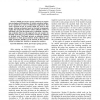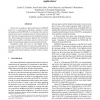114
Voted
PERCOM
2010
ACM
14 years 10 months ago
2010
ACM
Mobile peer-to-peer groups, which do not require any pre-deployed infrastructure or trusted centralized authority are valuable for a variety of collaborative applications. This wor...
109
Voted
IPPS
1998
IEEE
15 years 4 months ago
1998
IEEE
A real-time system must execute functionally correct computations in a timely manner. In order to guarantee that all tasks accepted in the system will meet their timing requiremen...
135
click to vote
MSWIM
2005
ACM
15 years 6 months ago
2005
ACM
The increase of IEEE 802.11’s bandwidth led to a deployment of many multimedia applications over wireless networks. Nevertheless, these applications impose stringent constraints...
106
click to vote
MOBIQUITOUS
2005
IEEE
15 years 6 months ago
2005
IEEE
As wireless networks become more prevalent, users will demand the same applications that are currently available in wired networks. Further, they will expect to receive a quality ...
103
Voted
ISM
2005
IEEE
15 years 6 months ago
2005
IEEE
In this work we propose a QoS architecture for MANETs based on a probe-based distributed admission control mechanism and the IEEE 802.11e technology. Our aim is to improve peer-to...
EUROMICRO
2005
IEEE
15 years 6 months ago
2005
IEEE
MANET environments suffer from changing connectivity conditions and radio contention among stations that conform it. Despite the several on-going endeavors, no simple and effectiv...
103
Voted
AINA
2005
IEEE
15 years 6 months ago
2005
IEEE
In this paper, we intend to solve the problem of maximum-revenue multicast routing with a partial admission control mechanism for multirate multimedia distribution. Specifically, ...
108
Voted
ICC
2008
IEEE
15 years 7 months ago
2008
IEEE
— In this paper, we analyze the performance of the Load-Level-Based Admission Control mechanism (LLAC) for optical burst-switched networks in a multilink scenario. The goal of th...
138
Voted
CCGRID
2008
IEEE
15 years 7 months ago
2008
IEEE
—Current data-centers employ admission control mechanism to maintain low response time and high throughput under overloaded scenarios. Existing mechanisms use internal (on the ov...



